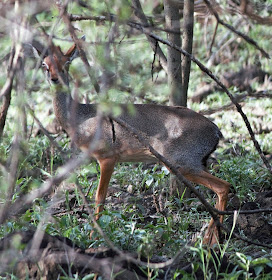 |
| Gelada male |
Following
our twitch of the restricted Ethiopian endemic, the Ankober Serin
(see here) at Gemessa Gebel, we chanced upon three
fair-sized troops of Gelada Baboons on the edge of juniper forest
near the cliff edges. This species, endemic to the Ethiopian
highlands, has long been high on my wish-list. We watched them for
some time, noting that they seemed largely unconcerned by us but
quickly scurried off into the forest when herdsmen with goats
appeared.
 |
| Gelada family group |
An
Ethiopian Rock Hyrax was among the rocks below the cliff edge.
 |
| Ethiopian Rock Hyrax |
After
a second night in Debre Libanos, we headed southwards, back towards
Addis Ababa, seeing several Blue-winged Geese close to the road. A
pair of Moorland Francolins on a rocky hillside was unexpected, while
Abyssinian Longclaw at last put in an appearance.
 |
| Blue-winged Goose |
 |
| Abyssinian Longclaw |
 |
| Moorland Francolin |
We
drove through the capital, being stopped along way for an unwelcome
and intrusive baggage search by roadside police. We continued south
through the Rift Valley and on towards our destination for the next
three nights – Awash Falls Lodge in Awash National Park, passing
through Adama. We stopped at the Mt Fantalle lava flow by Lake
Beseka. Here we quickly found one of the specialties of this hot and
arid landscape – Blackstart. This was followed shortly after by a
vocal pair of Sombre Rock-Chats, the other specialty of the site.
 |
| Blackstart |
 |
| Sombre Rock-Chat |
By
the lake were a few waterbirds including Pink-backed Pelican,
Yellow-billed Stork and Saddle-billed Stork. We entered the national
park and the dry thorn scrub along the road to the lodge held plenty
of birds including Mouse-coloured Penduline-Tit, Yellow-necked
Spurfowl, Buff-bellied Warbler and Grey Wren-Warbler.
 |
| :Pink-backed Pelican |
 |
| Saddlebill Stork |
 |
| Yellow-necked Spurfowl |
Hornbills
were well represented with African Grey, Northern Red-billed, Van Der
Decken's and Eastern Yellow-billed seen.
 |
| African Grey Hornbill |
 |
| Northern Red-billed Hornbill |
 |
| Eastern Yellow-billed Hornbill |
The
next day we had a long drive through the acacia scrub and plains
where mammals included Lesser Kudu, Salt's Dick-Dik, Beisa Oryx and
Soemmerring's Gazelle.
 |
| Beisa Oryx |
 |
| Salt's Dik-dik |
 |
| Soemmerring's Gazelle |
Buff-breasted,
Kori and Hartlaub's bustards were all encountered.
 |
| Buff-crested Bustard |
Other birds
included Northern Carmine Bee-eater, Abyssinian Roller, Dark Chanting
Goshawk and Red-fronted Warbler.
 |
| Abyssinian Roller |
 |
| Dark Chanting Goshawk |
 |
| Northern Carmine Bee-eater |
Gillett's
Lark was good to see and Singing Bushlark was present, along with
large numbers of Chestnut-headed and Chestnut-backed Sparrowlarks.
 |
| Gillett's Lark L |
 |
| Chestnut-backed Sparrowlark |
 |
| Chestnut-headed Sparrowlark |
Grey-headed
Batis was a previously missed species that was good to catch up on,
while Somali Bulbul, a recent split, was slightly less inspiring.
 |
| Grey-headed Batis |
In
the tall acacias along the river at the now disused camping ground
was a group of noisy Black-billed Wood-Hoopoes. Bruce's Green-Pigeon
and Little Sparrowhawk were present.
 |
| Black-billed Wood-Hoopoe |
Primates
were in fine form here with Olive Baboon, Grivet Monkey and Guereza
Colobus about in some numbers.
 |
| Grivet Monkey |
 |
| Guereza Colobus |
 |
| Olive Baboon |
A Nile Crocodile sunned itself on the
river bank; these reptiles were also common on the rocks below our
lodge.
 |
| Nile Crocodile |
We
headed out at dusk for a nightjar search and were rewarded with fine
views of three Star-spotted Nightjars, as well as Slender-tailed
Nightjar. Abyssinian (Cape) Hare was also seen.
 |
| Abyssinian Hare |
 |
| Star-spotted Nightjar |
On
our final morning we encountered a troop of Hamadryas Baboons along
the main road, which links Addis Ababa with Djibouti.
 |
| Hamadryas Baboon |

































No comments:
Post a Comment